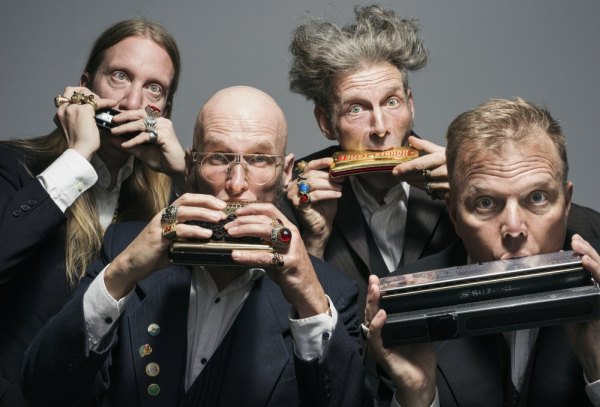

Sväng
Perhaps the idea of a harmonica quartet might evoke some kind of music-hall novelty act, but Sväng is a combo of amazing skill and creativity making a big, fat, complex sound using only harmonicas, from the familiar diatonic blues type and chromatic through double-sided and the keyed Harmonetta to big chuffing bass. Bass harmonica isn’t acoustically very loud, but its beefy deepness in the ensemble, and the overall completeness of the band’s sound, is a product of band member and sound engineer Jouko Kyhälä’s devising of ingenious close-miking and amplifying techniques for all the instruments, both live and in the studio.
This tenth album also sees the introduction of an extra tone color from a new Suzuki instrument, the Cello Bass low-tuned chromatic harp. It’s used in Kyhälä’s “Markku-ukolle” (“The old man Markku”), a traditional-style funeral march in honor of his father-in-law that moves between mournfulness and a happier celebration of a life. His “Liukas Luikku” (“Slippery Slim Slope”) is a bouncy, dance-impelling tune for the Finnish folk-dance form enkeliska.
Tango, in its Finnish mournful minor-key form, has long been so popular in Finland that it’s become pretty much traditional, danced in a Finnish way, characteristically un-showy and far from the fiery passion of Bueno Aires. Eero Grundström, in his note to the title track, drolly compares his country’s tango-dance floor moves to another Finnish activity, cross-country skiing. (In the booklet notes the band members helpfully give a lot of information, in English, on their compositions). While very fond of Finnish tango, Grundström has a particular enthusiasm for actual Argentinian tango, specifically here that of the remarkable, theatrical singer Melingo (whose performances I highly recommend). And so his “Svängo Nuevo,” which opens the album, has a lot of the hip-swaying sinuousness of Melingo’s milonga as it moves through ingenious melodic and rhythmic shifts, its lead changing from Hugo Diaz-influenced twin chromatic harmonicas to pitch-bending blues harp, and incorporating a hint of a Finnish traditional song.
There’s another quote of a well-known Finnish song, and also of a Finnish-American one, in “Nälkämaan lokari” (“Lumberjack from hunger-land”), which shifts up the gears from a steady chug to an ever faster-paced dance. It’s Grundström’s homage to the Finnish-American music that arose from the largely hunger-motivated migration, mostly between 1870 and 1930, of hundreds of thousands of Finns to America, where many did indeed become lumberjacks and farmers. (I remember singer Ruth Mackenzie saying that as a child in Minnesota she always assumed that Finnish was just the way farmers spoke; she didn’t realize there was a whole country across the sea speaking it!).
Grundström lives in a tiny village called Kantele, which is also the name of Finland’s national instrument, so I strongly suspect that might have had an influence on his decision to move there. His third composition on the album, “Kanteleen kisavirsi,” evokes the playing of the smallest and oldest form of kantele, which has five strings tuned to the first five notes of the scale, its traditional music being a stream of variation of phrases using that limited range. The tune springs from Geero (as he’s known in the band to differentiate him from the other Eero, Eero Turkka) walking or dancing as he plays, in this case on mixolydian-tuned low D blues harp with Turkka on G blues harp.
Eero Turkka is deeply influenced by Balkan music, and his compositional contributions reflect that. So “Dai pet!” (“Gimme five!”) is in a Bulgarian 5/8 and, to make it even more quintuple, each part of the melody has five bars. After a keening slow blues-harp intro “Shirtolainen” moves into another Bulgarian rhythm, the 7/8 known as shirto, its title a neologism combining that word with siirtolainen, the Finnish for immigrant. The blues is also a Turkka enthusiasm, so in “Svänging the blues” the heavy slow-blues churn morphs, while keeping its essential blueness, to slither into Bulgarian rachenitsa 7/8 rhythm.
Tapani Varis, well known as a bassist and player of munniharppu (commonly known as jew’s harp), has recently replaced Pasi Leino as Sväng’s bass-harmonica player. This is the quartet’s first recording with him, and he’s composed two tunes for the album. “Vaaran takana” (“Behind the hill”) evokes the music of the wooden or horn wind instruments made and played in the past by Karelian shepherds to pass the time and keep predators at bay. A hefty, rather ominous bass-harmonica pattern underpins a winding, changing, shuffling melody on a pair of blues harps. His “Marrasvalssi” (“October waltz”) is a modulating waltz, putting to full use the chromatic harmonica and the pitch-bending abilities of blues harp, that brings the album to a swaying, reflective close.
Search RootsWorld
|